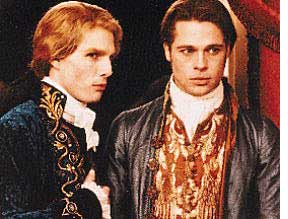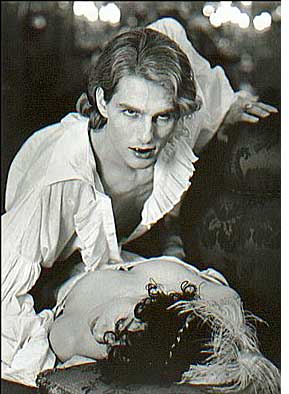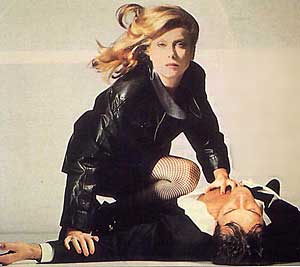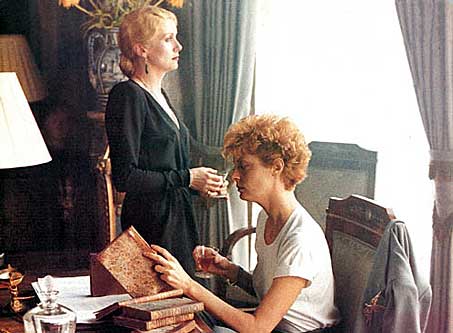|

Interview
With The Vampire
Warner Brothers,
1994
Director::
Neil Jordan
Screenplay:
Ann Rice
from
her novel
Starring:
Tom Cruise, Brad Pitt, Kristen Dunst, Antonio Banderas, Stephan Rhea,
Christian Slater
Rated R, 123 minutes

The
Hunger
1983
Director::
Tony Scott
Screenplay:
James Costigan, Ivan Davis, Michael Thomas
Starring:
Catherine Deneuve, David Bowie, Susan Sarandon, Beth Ehlers, Dan Hedaya
Rated R, 123 minutes
|
Lips
Together
Fangs Apart
by
Michael D. Klemm
Reprinted
from Outcome, September,
1999

It is not surprising
that vampires, known for often seducing their prey before they kill, have
traditionally been portrayed as heterosexual in the movies. Because they
feed on blood, the gender of the victim should be irrelevant but Count
Dracula still ignores Jonathan Harker and favors his fiancee. A few exceptions,
however, have surfaced in recent years. With Halloween close by, let's
take a second look at the two best known gay vampire flicks, Interview
With The Vampire and The Hunger.
 In
1994, Neil Jordan, director of the gender-bending The Crying Game,
seemed the ideal choice to bring Anne Rice's classic Interview
With The Vampire to the screen. Rice wrote the screenplay
herself but then took out a full page ad in Variety to express
her outrage over the casting of Hollywood's biggest pretty boy, Tom Cruise,
in the pivotal role. Widespread rumors whispered that Cruise wanted the
gay subtexts toned down or eliminated, as if playing a gay man would ruin
his "wholesome" image while playing a vampire would not. But
the rumors turned out to be unfounded and, for once, a fine story that
dripped with homoeroticism was not "de-gayed." In
1994, Neil Jordan, director of the gender-bending The Crying Game,
seemed the ideal choice to bring Anne Rice's classic Interview
With The Vampire to the screen. Rice wrote the screenplay
herself but then took out a full page ad in Variety to express
her outrage over the casting of Hollywood's biggest pretty boy, Tom Cruise,
in the pivotal role. Widespread rumors whispered that Cruise wanted the
gay subtexts toned down or eliminated, as if playing a gay man would ruin
his "wholesome" image while playing a vampire would not. But
the rumors turned out to be unfounded and, for once, a fine story that
dripped with homoeroticism was not "de-gayed."
 The
film's framing story takes place in present-day San Francisco. Brad Pitt
stars as Louis, a morose vampire who has granted an interview to a young
writer. Louis became a vampire in 1791. In life, he was a young New Orleans
plantation owner haunted by the loss of his wife. He strolls the waterfront,
inviting the local criminal element to kill him. Instead, he meets Lestat
(Tom Cruise). Louis quickly finds Lestat's teeth in his neck and falls
back in an orgasmic swoon. Lestat offers Louis a chance to escape his
pain, and transforms him into a vampire. The
film's framing story takes place in present-day San Francisco. Brad Pitt
stars as Louis, a morose vampire who has granted an interview to a young
writer. Louis became a vampire in 1791. In life, he was a young New Orleans
plantation owner haunted by the loss of his wife. He strolls the waterfront,
inviting the local criminal element to kill him. Instead, he meets Lestat
(Tom Cruise). Louis quickly finds Lestat's teeth in his neck and falls
back in an orgasmic swoon. Lestat offers Louis a chance to escape his
pain, and transforms him into a vampire.
 It
is important to note here that Rice's vampire mythos differs greatly from
the standard Hollywood formula. Instead of joining the undead when bitten,
their victims simply die. In order for Louis to become a vampire, Lestat
must first drain Louis' blood to the point of death. He then pierces his
own wrist and forces Louis to drink. The mix of Lestat's blood with his
own brings about the change. Thus, the making of a vampire involves a
conscious choice between both hunter and prey. It is, in some ways, almost
an act of love when Lestat chooses Louis to be his companion. It
is important to note here that Rice's vampire mythos differs greatly from
the standard Hollywood formula. Instead of joining the undead when bitten,
their victims simply die. In order for Louis to become a vampire, Lestat
must first drain Louis' blood to the point of death. He then pierces his
own wrist and forces Louis to drink. The mix of Lestat's blood with his
own brings about the change. Thus, the making of a vampire involves a
conscious choice between both hunter and prey. It is, in some ways, almost
an act of love when Lestat chooses Louis to be his companion.
Their "marriage"
however is far from happy. While Lestat is a born predator, Louis is uncomfortable
with having to kill. Lestat repeatedly urges Louis to embrace his "true
nature" and to stop running away from it. (Does this sound like a
coded treatment of homosexuality to anyone else here too?) When Louis
threathens to abandon Lestat, the two men become parents of a kind. Louis
pities, and then feeds, on a young girl named Claudia whom he finds starving
in a tenement. Lestat turns Claudia into a vampire so she can be a companion
for Louis. The three live as a family for over a century. Claudia, played
by Kirsten Dunst, is a unique character because she becomes a 100 year
old woman trapped in the body of a 12 year old girl. Her desire to "grow
up" leads to tragedy.
 Later,
they discover more of their kind living beneath a Paris theater. There,
Louis meets Armand (Antonio Banderas), the
world's oldest living vampire, who is bored with the old world ways of
his companions. He is drawn to Louis because he worships his youth and
sees him as a "bridge" to the next century. They share the film's
most erotic moment when they almost kiss. Later,
they discover more of their kind living beneath a Paris theater. There,
Louis meets Armand (Antonio Banderas), the
world's oldest living vampire, who is bored with the old world ways of
his companions. He is drawn to Louis because he worships his youth and
sees him as a "bridge" to the next century. They share the film's
most erotic moment when they almost kiss.
Why does Lestat choose
Louis? A simple answer might be his desire to share Louis' wealth, but
it is more complicated than that. The gay question enters here. He could
have chosen a woman to be his consort. Lestat is clearly attracted to
Louis and his attack is an obvious seduction. It is a credit to both actors
that they did not shirk away from this aspect to their characters. If
Lestat loves beauty, it seems perfectly natural for his prey to include
men as well as women.
 Interview
With The Vampire, on both the page and onscreen, fascinates
because of the completely new spin given to the old myths. I'll be honest,
the movie pales next to the book but director Jordan did an admirable
job in capturing its dark mood while peppering it with gallows humor.
The homoerotic element could have been taken further but I was happy with
what was there when I first saw it in the movie theater with my
partner, Andy. Pitt is marvelous as the angst-ridden Louis while Cruise
is positively exuberant as the callous Lestat. Is it a positive
depiction of homosexuality? Of course not, we're talking about a vampire
story here. Is the introduction of gay themes just another attempt
to be shocking? Perhaps in other hands, but Rice has stated in several
interviews that she considers herself to be a gay male trapped in a woman's
body. By the way, she changed her tune about Cruise after she viewed the
finished film. Interview
With The Vampire, on both the page and onscreen, fascinates
because of the completely new spin given to the old myths. I'll be honest,
the movie pales next to the book but director Jordan did an admirable
job in capturing its dark mood while peppering it with gallows humor.
The homoerotic element could have been taken further but I was happy with
what was there when I first saw it in the movie theater with my
partner, Andy. Pitt is marvelous as the angst-ridden Louis while Cruise
is positively exuberant as the callous Lestat. Is it a positive
depiction of homosexuality? Of course not, we're talking about a vampire
story here. Is the introduction of gay themes just another attempt
to be shocking? Perhaps in other hands, but Rice has stated in several
interviews that she considers herself to be a gay male trapped in a woman's
body. By the way, she changed her tune about Cruise after she viewed the
finished film.
[Reviewer's
note, 2007: I still think this film was bold for its day, but in light
of the recent behavior of one of the film's stars, it's hard to watch
it the same way anymore.]
|
|
Interview With
The Vampire
is stylish and boasts a very strong script. The
Hunger, on the hand, has style aplenty but is quite frankly
incoherent. Nonetheless, it's great to look at and it's a queer cinema
milestone of sorts.
 In
The Hunger, (1983), Catherine
Deneuve and David Bowie portray Miriam and John Blaylock, as vampires
of an elegant sort who've lived together for 200 years. The Bela Lugosi
archetype is completely dispensed with and given a facelift to reflect
modern times. Deneuve and Bowie are cool, beautiful, and the embodiment
of vampire chic! Impeccably dressed in punkish leather, they pick up a
young couple in a loud dance club and take them home. After going through
the motions of a hot seduction, both take Egyptian ankh necklaces and
slash their victims' throats. No fangs here. The victims, like Rice's,
simply die. Our "heroes" then play chamber music and generally
wander aimlessly around their classy, but tomb-like, mansion. "Forever
together," they keep telling each other. In
The Hunger, (1983), Catherine
Deneuve and David Bowie portray Miriam and John Blaylock, as vampires
of an elegant sort who've lived together for 200 years. The Bela Lugosi
archetype is completely dispensed with and given a facelift to reflect
modern times. Deneuve and Bowie are cool, beautiful, and the embodiment
of vampire chic! Impeccably dressed in punkish leather, they pick up a
young couple in a loud dance club and take them home. After going through
the motions of a hot seduction, both take Egyptian ankh necklaces and
slash their victims' throats. No fangs here. The victims, like Rice's,
simply die. Our "heroes" then play chamber music and generally
wander aimlessly around their classy, but tomb-like, mansion. "Forever
together," they keep telling each other.
 Until
suddenly John is sleepless and begins to age. He learns what is starting
to happen. Miriam has lived since the ancient Egyptian dynasty with consorts
of both sexes. After roughly 200 years, each consort suddenly ages and
"dies." Her ex-lovers are kept in crates in the attic, frozen
but still aware. Though Miriam loves John, and is clearly upset by his
decline, she has already chosen his successor. Until
suddenly John is sleepless and begins to age. He learns what is starting
to happen. Miriam has lived since the ancient Egyptian dynasty with consorts
of both sexes. After roughly 200 years, each consort suddenly ages and
"dies." Her ex-lovers are kept in crates in the attic, frozen
but still aware. Though Miriam loves John, and is clearly upset by his
decline, she has already chosen his successor.
John has paid a visit
to Dr. Sarah Roberts (Susan Sarandon), the
author of Sleep and Longevity. When Sarah sees John age 30 years
in her waiting room, she tracks him to his home. By this time, John has
already joined the others in the attic, and Miriam has eyes for Sarah.
Their seduction scene
is charged with sexual passion. The two women drink wine while Miriam
plays the piano. Miriam resembles the quintessential Hitchcock
blonde, icy and dressed to kill, while Sarah looks butch in a white t-shirt
and slacks. When Sarah spills wine on her shirt, Miriam helps clean up
and they begin to kiss. The subsequent bed scene is sensuously filmed
with billowing drapes and soft music while two of the most beautiful women
in the world make love and then drink from each other's veins.
 This
moment is justly famous because there have been many times when an actor
has to refused to play such a scene. Will Smith refused to kiss a man
in Six Degrees of Separation, for example. Sarandon rose above
this. She has stated on several occasions that the director had wanted
Miriam to get Sarah drunk and she asked why she would have to get drunk
to want to sleep with Catherine Deneuve??????? This
moment is justly famous because there have been many times when an actor
has to refused to play such a scene. Will Smith refused to kiss a man
in Six Degrees of Separation, for example. Sarandon rose above
this. She has stated on several occasions that the director had wanted
Miriam to get Sarah drunk and she asked why she would have to get drunk
to want to sleep with Catherine Deneuve???????
Unfortunately the
ending of The Hunger makes
little sense. But that shouldn't stop viewers from enjoying the rest for
its style. The photography is a visual feast and the editing resembles
a rock video's. Rent the widescreen edition if possible because the panoramic
compositions will greatly suffer on the standard pan & scan videotape.
 It's
difficult to determine whether director Tony Scott wanted to present a
groundbreaking lesbian love scene or if his interests were simply prurient.
The Hunger succeeds mostly
on the strength of its casting. Deneuve, a cherished lesbian icon since
her films with Truffaut, solidified her femme appeal in The
Hunger. Bowie is renowned for pushing the gay/bi envelope
in his glam rock days as Ziggy Stardust, even though he later denied ever
being really gay. Sarandan's sensuality had been used to great effect
in films like Atlantic City and Pretty Baby, but to many
she will always be remembered as Janet in The
Rocky Horror Picture Show. The presence of these actors brings an
unusual sexual dynamic that would surely have been lacking in the hands
of other performers. It's
difficult to determine whether director Tony Scott wanted to present a
groundbreaking lesbian love scene or if his interests were simply prurient.
The Hunger succeeds mostly
on the strength of its casting. Deneuve, a cherished lesbian icon since
her films with Truffaut, solidified her femme appeal in The
Hunger. Bowie is renowned for pushing the gay/bi envelope
in his glam rock days as Ziggy Stardust, even though he later denied ever
being really gay. Sarandan's sensuality had been used to great effect
in films like Atlantic City and Pretty Baby, but to many
she will always be remembered as Janet in The
Rocky Horror Picture Show. The presence of these actors brings an
unusual sexual dynamic that would surely have been lacking in the hands
of other performers.
Interview
With The Vampire is an ambitious film that delves into
matters such as the nature of God and explores the pyschological make-up
of a vampire. It is the stronger of the two films, but The
Hunger will be more fun at a Halloween party. Both can
be rented at video stores everywhere.
More
On Susan Sarandon
The Rocky Horror Picture Show
Antonio Banderas
also appears in:
Law Of Desire
Philadelphia
|


